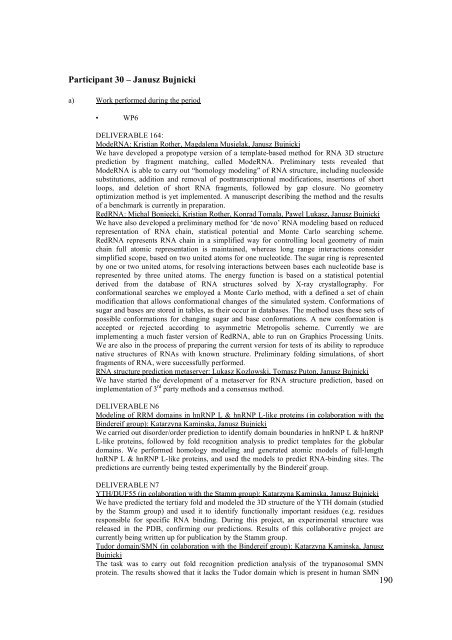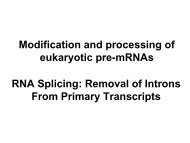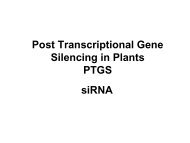You also want an ePaper? Increase the reach of your titles
YUMPU automatically turns print PDFs into web optimized ePapers that Google loves.
Participant 30 – Janusz Bujnickia) Work performed during the period• WP6DELIVERABLE 164:ModeRNA: Kristian Rother, Magdalena Musielak, Janusz BujnickiWe have developed a propotype version of a template-based method for RNA 3D structureprediction by fragment matching, called ModeRNA. Preliminary tests revealed thatModeRNA is able to carry out “homology modeling” of RNA structure, including nucleosidesubstitutions, addition and removal of posttranscriptional modifications, insertions of shortloops, and deletion of short RNA fragments, followed by gap closure. No geometryoptimization method is yet implemented. A manuscript describing the method and the resultsof a benchmark is currently in preparation.RedRNA: Michal Boniecki, Kristian Rother, Konrad Tomala, Pawel Lukasz, Janusz BujnickiWe have also developed a preliminary method for ‘de novo’ RNA modeling based on reducedrepresentation of RNA chain, statistical potential and Monte Carlo searching scheme.RedRNA represents RNA chain in a simplified way for controlling local geometry of mainchain full atomic representation is maintained, whereas long range interactions considersimplified scope, based on two united atoms for one nucleotide. The sugar ring is representedby one or two united atoms, for resolving interactions between bases each nucleotide base isrepresented by three united atoms. The energy function is based on a statistical potentialderived from the database of RNA structures solved by X-ray crystallography. Forconformational searches we employed a Monte Carlo method, with a defined a set of chainmodification that allows conformational changes of the simulated system. Conformations ofsugar and bases are stored in tables, as their occur in databases. The method uses these sets ofpossible conformations for changing sugar and base conformations. A new conformation isaccepted or rejected according to asymmetric Metropolis scheme. Currently we areimplementing a much faster version of RedRNA, able to run on Graphics Processing Units.We are also in the process of preparing the current version for tests of its ability to reproducenative structures of RNAs with known structure. Preliminary folding simulations, of shortfragments of RNA, were successfully performed.RNA structure prediction metaserver: Lukasz Kozlowski, Tomasz Puton, Janusz BujnickiWe have started the development of a metaserver for RNA structure prediction, based onimplementation of 3 rd party methods and a consensus method.DELIVERABLE N6Modeling of RRM domains in hnRNP L & hnRNP L-like proteins (in colaboration with theBindereif group): Katarzyna Kaminska, Janusz BujnickiWe carried out disorder/order prediction to identify domain boundaries in hnRNP L & hnRNPL-like proteins, followed by fold recognition analysis to predict templates for the globulardomains. We performed homology modeling and generated atomic models of full-lengthhnRNP L & hnRNP L-like proteins, and used the models to predict RNA-binding sites. Thepredictions are currently being tested experimentally by the Bindereif group.DELIVERABLE N7YTH/DUF55 (in colaboration with the Stamm group): Katarzyna Kaminska, Janusz BujnickiWe have predicted the tertiary fold and modeled the 3D structure of the YTH domain (studiedby the Stamm group) and used it to identify functionally important residues (e.g. residuesresponsible for specific RNA binding. During this project, an experimental structure wasreleased in the PDB, confirming our predictions. Results of this collaborative project arecurrently being written up for publication by the Stamm group.Tudor domain/SMN (in colaboration with the Bindereif group): Katarzyna Kaminska, JanuszBujnickiThe task was to carry out fold recognition prediction analysis of the trypanosomal SMNprotein. The results showed that it lacks the Tudor domain which is present in human SMN190







